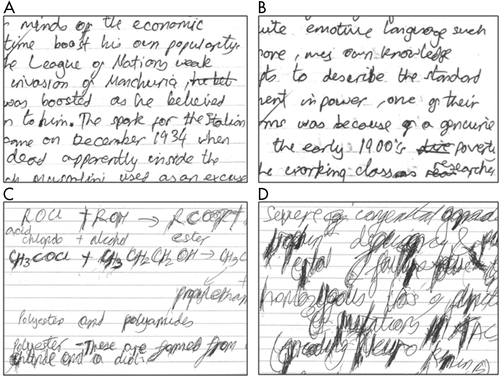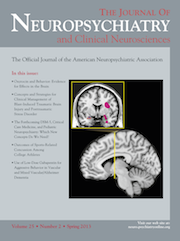Handwriting Abnormality in Tourette Syndrome
To the Editor: Tourette syndrome (TS) is a neurodevelopmental disorder characterized by multiple motor tics and one or more phonic tics. TS is often associated with specific behavioral problems, and concomitant obsessive-compulsive symptoms (OCSs) are commonly reported.1 The varied nature of tics and comorbid neuropsychiatric symptoms can result in a patient’s quality of life being affected in multiple, often unexpected ways.2
We report the case of a 20-year-old male student who was referred to the specialist TS clinic for a 7-year history of multiple motor tics, involving the face, neck, upper limbs, and torso, as well as simple phonic tics, namely, grunting and throat-clearing. The tics characteristically varied in pattern and intensity over time, were exacerbated by stressful situations, and were preceded by premonitory urges, which were transiently relieved by tic expression. A total score of 57% on the Yale Global Tic Severity Scale confirmed moderate-to-marked tic severity. Despite a slightly late age at tic onset, this patient scored 63% on the TS Diagnostic Confidence Index, which is in line with the average scores from specialist clinics. There was no evidence of complex tic-related symptoms such as echo, pali (repetition), and copro-phenomena, however this patient reported a peculiar problem with his writing, which was severely compromising his health-related quality of life. He described how he became progressively fixated on letters and developed the urge to outline each letter multiple times when producing handwriting. This repetitive behavior severely compromised the intelligibility and fluency of the handwriting. A review of handwriting samples from the previous 7 years (Figure 1) showed features of both reiterative and spatial agraphia, with progressive deterioration of graphic output, to the point where computer-assisted tools were deemed necessary to sit written university examinations.

A few tic-related symptoms that manifest in handwriting have been previously reported in TS. These include echographia, the pathological rewriting of phrases produced by the reader; coprographia, the compulsive writing or drawing of obscenities; and paligraphia, the abnormal repetition of written letters, words, or phrases, often in the form of written jocularity.3 It is unclear, however, whether the writing abnormality observed in this patient is a manifestation of TS or a comorbid OCS, as, in clinical settings, it is often difficult to distinguish complex tics from compulsions.4 Repetitive behaviors are commonly reported in TS as part of the tic-related clinical spectrum, including repetitive counting (arithmomania), checking, and “evening-up” behaviors, which are characteristically driven by concerns for symmetry and ‘just-right’ perceptions.4,5 Interestingly, our patient did not report other OCSs and did not respond to fluoxetine. He was unwilling to try other serotonergic or antidopaminergic medications for tic management. Taken together, these observations suggest that this peculiar handwriting abnormality is to be added to the multifaceted tic repertoire ascribed to TS. To the best of our knowledge, this is the first report of a complex tic-related symptom potentially affecting key components of daily functioning by interfering with otherwise proficient writing skills.
1 : The behavioral spectrum of Gilles de la Tourette syndrome. J Neuropsychiatry Clin Neurosci 2009; 21:13–23Link, Google Scholar
2 : The Gilles de la Tourette Syndrome Quality-of-Life Scale (GTS-QOL): development and validation. Neurology 2008; 71:1410–1416Crossref, Medline, Google Scholar
3 : Paligraphia and written jocularity in Gilles de la Tourette syndrome. Mov Disord 2011; 26:930–931Crossref, Medline, Google Scholar
4 : Tic or compulsion?: it’s Tourettic OCD. Behav Modif 2005; 29:784–799Crossref, Medline, Google Scholar
5 : Repetitive behaviours in patients with Gilles de la Tourette syndrome: tics, compulsions, or both? PLoS ONE 2010; 5:e12959Crossref, Medline, Google Scholar



